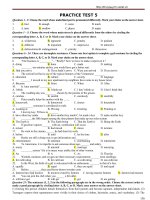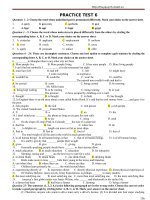- Trang chủ >>
- THPT Quốc Gia >>
- Ngoại Ngữ
Thi online bài luyện tập 1 (cô hồng hạnh)
Bạn đang xem bản rút gọn của tài liệu. Xem và tải ngay bản đầy đủ của tài liệu tại đây (254.92 KB, 4 trang )
7/5/2016
Thi online Bài luyện tập 1 (cô Hồng Hạnh) |
Fort Knox, Kentucky, is the site of a U.S. army post, but it is even more renowed for the Fort Knox Bullion
Depository, the massive vault that contains the bulk of the U.S. government’s gold deposits. Completed in 1936,
the vault is housed in a twostory building constructed of granite, steel, and concrete; the vault itself is made of
steel and concrete and has a door that weighs more than twenty tons. Naturally, the most uptodate security
devices available are in place at Fort Knox, and the army post nearby provides further protection.
A
Which of the following best describes the topic of the paragraph?
The city of Fort Knox, Kentucky
B
The federal gold depository
C
The U.S. army post at Fort Knox
Câu 1
D
Gold bullion
A
Which of the following would be the best title for this passage?
The Massive Concrete Vault
B
Fort Knox Security
C
Where the U.S. Keeps Its Gold
Câu 2
D
A Visit to Kentucky
One identifying characteristics of minerals is their relative hardness, which can be determined by scratching one
mineral with another. In this type of test, a harder mineral can scratch a softer one, but a softer mineral is unable
to scratch the harder one. The Mohs’ hardness scale is used to rank minerals according to their hardness. Ten
minerals are listed in this scale, ranging from talc with a hardness of 1 to diamond with a hardness of 10. On this
scale, quartz (number 7) is harder than feldspar (number 6) and is therefore able to scratch it; however, feldspar
is unable to make a mark on quartz.
Câu 1
A
C
Câu 2
A
C
Which of the following best states the subject of this paragraph?
The hardness of diamonds
B
Identifying minerals by means of a scratch
test
Feldspar on the Moh’s scale
D
Recognizing minerals in their natural state
The main idea of this passage is that
The hardness of a mineral can be determined
by its ability to make a mark on other
minerals
A softer mineral cannot be scratched by a
harder minerals
B
Diamonds, with a hardness of 10 on the
Moh’s scale, can scratch all other minerals
D
Talc is the first mineral listed on the Moh’s
scale
Henry Wadsworth Longfellow (1807 – 1882) was perhaps the bestknown American poet of the nineteenth
century. His clear writing style and emphasis on the prevelant values of the period made him popular with the
general public if not always with the critics. He was particularly recognized for his longer narrative poems
Evangeline, The Song of Hiawatha, and The Courtship of Miles Standish, in which he told stories from
American history in terms of the values of the time.
Evangeline was set during the French and Indian War (1754 – 1763), when the British forced French settlers
from Nova Scotia; two lovers, Gabriel and Evangeline, were separated by the British and Evangeline devoted
her lifetime to the search of Gabriel. With its emphasis on sentimental undying love, Evangeline was immensely
popular with the public.
In The Song of Hiawatha, Longfellow depicted the noble life of the American Indian through the story of the
brave Hiawatha and his beloved wife Minehaha. The tearinspiring poem follow Hiawatha through the tragedies
and triumphs of life, ending with the death of Minehaha and Hiawatha’s departure into the sunset with his
canoe.
The Courtship of Miles Standish takes place during the early period of the settlement of New England, a period
which was viewed as a time of honor and romance. In this poem centered around a love triangle, Miles Standish
asks his friend John Alden to propose to Priscilla Mullins for him. John Alden ends up marrying Priscilla
file:///D:/Users/Le/Desktop/All/a.html
1/4
7/5/2016
Thi online Bài luyện tập 1 (cô Hồng Hạnh) |
asks his friend John Alden to propose to Priscilla Mullins for him. John Alden ends up marrying Priscilla
Mullins himself, and it takes time for this friendship with Miles Standish to recover. As with Longfellow’s other
narrative poems, the emphasis on high ideal and romance made the poem extremely popular.
Câu 1
A
C
Câu 2
A
C
Câu 3
A
C
Which of the following best describes the main idea of the passage?
American history is often depicted in poetry.
B
Longfellow described American history
eventhough people really did not enjoy it.
Tile popularity of Longfellow’s poems
D
Longfellow wrote long narrative poems that
results from his stress on the values of the
was not always popular with critics.
people.
The best title of the passage is
Longfellow’s Popular Appeal
The Lyric, Dramatic, and Narrative Poems of
Longfellow
The subject of the fourth paragraph is
nobility and honor in the poems of
Longfellow
the popular appeal of The Courtship of Miles
Standish
B
Historical Narrative Poems
D
Longfellow and the Critics
B
the love triangle involving Miles Standish
D
the period of title early settlement of New
England
You should spend 20 minutes on Questions 813 which are based on the passage below.
Questions 813
The reading passage below has seven paragraphs AG
From this list of headings below choose the most suitable heading for each paragraph.
List of headings
98.jpg
Question 8 Paragraph A
Question 9 Paragraph B
Question 10 Paragraph C
Question 11 Paragraph D
Question 12 Paragraph E
Question 13 Paragraph F
Example: Paragraph G ii
ROBOTS
Since the dawn of human ingenuity, people have devised ever more cunning tools to cope with work that
is dangerous, boring, onerous, or just plain nasty. That compulsion has culminated in robotics – the
science of conferring various human capabilities on machines.
file:///D:/Users/Le/Desktop/All/a.html
2/4
7/5/2016
Thi online Bài luyện tập 1 (cô Hồng Hạnh) |
science of conferring various human capabilities on machines.
A. The modern world is increasingly populated by quasiintelligent gizmos whose presence we barely notice but
whose creeping ubiquity has removed much human drudgery. Our factories hum to the rhythm of robot
assembly arms. Our banking is done at automated teller terminals that thank us with rote politeness for the
transaction. Our subway trains are controlled by tireless robodrivers. Our mine staffs are dug by automated
moles, and our nuclear accidents such as those at Three Mile Island and Chernobyl are cleaned up by robotic
muckers fit to withstand radiation.
Such is the scope of uses envisioned by Karel Capek, the Czech playwright who coined the term ‘robot’ in 1920
(the word ‘robota’ means ‘forced labor’ in Czech). As progress accelerates, the experimental becomes the
exploitable at record place.
B. Other innovations promise to extend the abilities of human operators. Thanks to the incessant miniaturisation
of electronics and micromechanics, there are already robot systems that can perform some kinds of brain and
bone surgery with submillimeter accuracy far greater precision than highly skilled physicians can achieve with
their hands alone. At the same time, techniques of longdistance control will keep people even farther from
hazard. In 1994 a tenfoottall NASA robotic explorer called Dante, with videocamera eyes and with spiderlike
legs, scrambled over the menacing rim of an Alaskan volcano while technicians 2,000 miles away in California
watched the scene by satellite and controlled Dante’s descent.
C. But if robots are to reach the next stage of laboursaving utility, they will have to operate with less human
supervision and be able to make at least a few decisions for themselves goals that pose a formidable challenge.
‘While we know how to tell a robot to handle a specific error,’ says one experts, ‘we can’t yet give a robot
enough common sense to reliably interact with a dynamic world.’ Indeed the quest for true artificial intelligence
(AI) has produced very mixed results. Despite a spasm of initial optimism in the 1960s and 1970s, when it
appeared that transistor circuits and microprocessors might be able to perform in the same way as the human
brain by the 21st century, researchers lately have extended their forecasts by decades if not centuries.
D. What they found, in attempting to model thought, is that the human brain’s roughly one hundred billion
neurons are much more talented and human perception far more complicated than previously imagined. They
have built robots that can recognise the misalignment of a machine in a controlled factory environment. But the
human mind can glimpse a rapidly changing scene and immediately disregard the 98 per cent that is irrelevant
instantaneously focusing on the woodchuck at the side of a winding forest road or the single suspicious face in a
tumultuous crowd. The most advanced computer systems on Earth can’t approach that kind of ability, and
neuroscientists still don’t know quite how we do it.
E. Nonetheless, as information theorists, neuroscientists, and computer experts pool their talents, they are
finding ways to get some lifelike intelligence from robots. One method renounces the linear, logical structure of
conventional electronic circuits in favour of the messy, ad hoc arrangement of a real brain’s neurons. These
‘neural networks’ do not have to be programmed. They can ‘teach’ themselves by a system of feedback signals
that reinforce electrical pathways that produced correct responses and, conversely, wipe out connections that
produced errors. Eventually the net wires itself into a system that can pronounce certain words or distinguish
certain shapes.
F. In other areas researchers are struggling to fashion a more natural relationship between people and robots in
the expectation that some day machines will take on some tasks now done by humans in, say, nursing homes.
This is particularly important in Japan, where the percentage of elderly citizens is rapidly increasing. So
experiments at the Science University of Tokyo have created a ‘face robot’ a lifesize, soft plastic model of a
female head with a video camera imbedded in the left eye as a prototype. The researchers’ goal is to create
robots that people feel comfortable around. They are concentrating on the face because they believe faical
expressions are the most important way to transfer emotional messages. We read those messages by interpreting
expressions to decide whether a person is happy, frightened, angry, or nervous. Thus the Japanese robot is
designed to detect emotions in the person it is ‘looking at’ by sensing changes in the spatial arrangement of the
person’s eyes, nose, eyebrows, and mouth. It compares those configurations with a database of standard facial
expressions and guesses the emotion. The robot then uses an ensemble of tiny pressure pads to adjust its plastic
fact into an appropriate emotional response.
file:///D:/Users/Le/Desktop/All/a.html
3/4
7/5/2016
Thi online Bài luyện tập 1 (cô Hồng Hạnh) |
G. Other labs are taking a different approach, one that doesn’t try to mimic human intelligence or emotions. Just
as computer design has moved away from one central mainframe in favour of myriad individual workstations
and single processors have been replaced by arrays of smaller units that break a big problem into parts that are
solved simultaneously many experts are now investigating whether swarms of semismart robots can generate
a collective intelligence that is greater than the sum of its parts. That’s what beehives and ant colonies do, and
several teams are betting that legions of minicritters working together like ant colony could be sent to explore
the climate of planets or to inspect pipes in dangerous industrial situations.
file:///D:/Users/Le/Desktop/All/a.html
4/4




